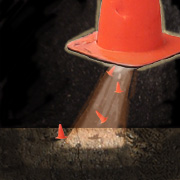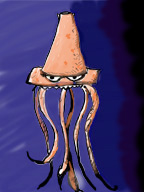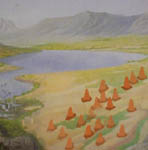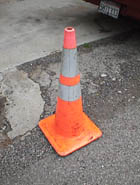


 The origin of the modern traffic cone is a mystery that has perplexed researchers for decades. There are few similarities between Conus and any other species living today, leading scientists to believe that it diverged from from the evolutionary tree quite early. Its flat foot, distinctive cone-shaped body, and lack of appendages evolved for reasons not entirely known. Theories abound of divine intervention and alien master plans, but there is little concrete evidence to support such claims.
The origin of the modern traffic cone is a mystery that has perplexed researchers for decades. There are few similarities between Conus and any other species living today, leading scientists to believe that it diverged from from the evolutionary tree quite early. Its flat foot, distinctive cone-shaped body, and lack of appendages evolved for reasons not entirely known. Theories abound of divine intervention and alien master plans, but there is little concrete evidence to support such claims.
 The most commonly held opinion upon the origins of Conus, and that with the most evidence, was presented by Dr. Edgar Blascon at The National Conference of Conology last April. His research compared the physiology of the modern cone with that of the ancient squid, Polypodis narensis. Narensis and present day cones share many features, including a distinctively tapering body. Dr. Blascon believes these squid began leaving the water in search of safety in the late Cretaceous period. Although the first "land squids" might have seemed helpless beasts, Dr. Blascon asserts that they most probably had strong beaks and might have been inedible, or even poisonous to the touch, as in the case of modern day Conus Esthericus.
The most commonly held opinion upon the origins of Conus, and that with the most evidence, was presented by Dr. Edgar Blascon at The National Conference of Conology last April. His research compared the physiology of the modern cone with that of the ancient squid, Polypodis narensis. Narensis and present day cones share many features, including a distinctively tapering body. Dr. Blascon believes these squid began leaving the water in search of safety in the late Cretaceous period. Although the first "land squids" might have seemed helpless beasts, Dr. Blascon asserts that they most probably had strong beaks and might have been inedible, or even poisonous to the touch, as in the case of modern day Conus Esthericus.
 Over time, as nature favored larger and larger dinosaurs, it also favored massive cones. Evidence of this "Megalacone" was found by Dr. Mildred T. Orange in the form of a massive cone foot print. If modern foot-to-body ratios hold true, this ancient cone would have stood 120 feet tall. At this height, and cone-shaped, the Megalacone would have resembled a small volcano. The evolutionary process perfected this rather effective masquerade, ridding cones of unecessary appendages and reducing sensory organs.
Over time, as nature favored larger and larger dinosaurs, it also favored massive cones. Evidence of this "Megalacone" was found by Dr. Mildred T. Orange in the form of a massive cone foot print. If modern foot-to-body ratios hold true, this ancient cone would have stood 120 feet tall. At this height, and cone-shaped, the Megalacone would have resembled a small volcano. The evolutionary process perfected this rather effective masquerade, ridding cones of unecessary appendages and reducing sensory organs.
 As the climate changed and dinosaurs disappeared, cones became smaller. Smaller cones were much more mobile than their heavier counterparts, allowing them to travel to warmer, more hospitable climes.To avoid predation, they traveled in packs. It was then that cones began to exhibit the altruistic tendencies they still possess today. It appears that cones would gather near hazards such as tar pits and quicksand to warn others of these dangers. This behavior preserved members of their herd, and allowed the species to prosper. Other creatures learned to take advantage of these warnings too, and avoided cones instead of eating them.
As the climate changed and dinosaurs disappeared, cones became smaller. Smaller cones were much more mobile than their heavier counterparts, allowing them to travel to warmer, more hospitable climes.To avoid predation, they traveled in packs. It was then that cones began to exhibit the altruistic tendencies they still possess today. It appears that cones would gather near hazards such as tar pits and quicksand to warn others of these dangers. This behavior preserved members of their herd, and allowed the species to prosper. Other creatures learned to take advantage of these warnings too, and avoided cones instead of eating them.
 The Automobile Age was a time of profound and rapid change for Conus. Burgeoning road construction attracted cones, and most left the valleys and the fields to live on the new roads. They flocked to construction work sites, potholes, and other road hazards. Unfortunately, these new environs did not favor all cones. Species of grey and black cones that had previously flourished were rendered almost extinct, as automobiles were much less likely to see them upon the asphalt. Nature began to favor only the brightest and most visible of cones, which tended to be red, yellow, and orange.
The Automobile Age was a time of profound and rapid change for Conus. Burgeoning road construction attracted cones, and most left the valleys and the fields to live on the new roads. They flocked to construction work sites, potholes, and other road hazards. Unfortunately, these new environs did not favor all cones. Species of grey and black cones that had previously flourished were rendered almost extinct, as automobiles were much less likely to see them upon the asphalt. Nature began to favor only the brightest and most visible of cones, which tended to be red, yellow, and orange.
 The most recent evolutionary adaptation is the Reflective Stripe. This feature increases the visibility of cones at night. Whether this evolutionary adaptation will threaten the dominance of the Orange ConeCone is yet to be seen...
The most recent evolutionary adaptation is the Reflective Stripe. This feature increases the visibility of cones at night. Whether this evolutionary adaptation will threaten the dominance of the Orange ConeCone is yet to be seen...